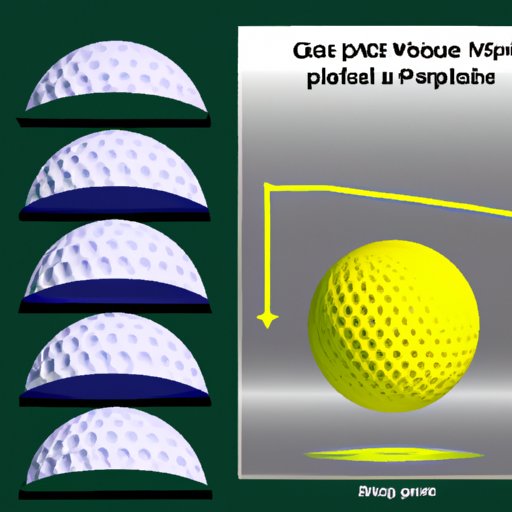Introduction
Golf balls have dimples for a variety of reasons, but what are they and how do they work? This article looks at the physics, flight paths, and benefits of golf ball dimples to help you understand why they’re so important. We’ll explore the history of golf ball dimples, the technology used to create them, and the advantages of using them. We’ll also compare different types of dimples and their effects on performance.
Exploring the Physics of Golf Ball Dimples
The physics of golf ball dimples is complex and can be difficult to understand. But, in simple terms, dimples help create lift and reduce drag. When a golf ball is hit, the dimples create pockets of low pressure around the ball which helps it fly farther. As the ball spins, the dimples also help reduce the amount of air resistance or drag, allowing it to travel faster.
The spin of a golf ball also plays an important role in its flight path. The dimples help create a stable flight pattern by reducing turbulence and increasing the stability of the ball in the air. This means that the golfer can control the trajectory of the ball more accurately.
How Dimples Impact the Flight Path of a Golf Ball
The depth of the dimples on a golf ball can have a significant impact on its flight path. Deeper dimples will produce higher launch angles, meaning the ball will fly further. Shallow dimples, on the other hand, will result in lower launch angles and shorter distances.
Different dimple patterns can also affect the flight path of a golf ball. For example, some dimple patterns are designed to produce less spin, resulting in straighter shots. Others are designed to generate more spin, creating a draw or fade effect. The type of dimple pattern you choose can have a big impact on your game.
Finally, dimples can also influence the trajectory of a golf ball. Dimples help reduce drag, which can lead to a higher apex and a more consistent flight path. This can give you greater control over the distance and direction of your shots.

Investigating the History of Golf Ball Dimples
The history of golf ball dimples dates back to the early 1900s when wooden balls were replaced with rubber-based ones. At first, these balls had smooth surfaces but soon engineers began experimenting with different designs. They found that adding indentations to the surface of the ball improved its performance in the air.
These early golf balls were made from rubber and featured a dimple design that was similar to that of a modern golf ball. Over time, the designs became more advanced as manufacturers experimented with different shapes and sizes. Eventually, the dimple pattern we know today was developed.
Today, dimpled golf balls are the norm and are used by professional golfers all over the world. They’re essential for improving performance and accuracy, and they’ve become a key part of the game.

Examining the Technology Behind Golf Ball Dimples
The technology behind golf ball dimples is quite impressive. Most modern golf balls are made from synthetic materials such as polybutadiene and Surlyn. These materials are lightweight and durable, making them ideal for golf ball production.
The dimples themselves are created using a process called injection molding. This involves injecting molten material into molds that have been designed to create the desired dimple shape and size. The molds are then cooled and the dimples are formed.
Some high-end golf balls also feature advanced design features such as “micro-dimples.” These tiny dimples are designed to improve the aerodynamics of the ball, resulting in even further improvements in performance.

Analyzing the Benefits of Golf Ball Dimples
Golf ball dimples offer several advantages that can improve your game. The most obvious benefit is increased distance. Dimples help create lift and reduce drag, which leads to longer drives and more accurate shots.
Dimples also provide better control over the flight path of the ball. By reducing turbulence and providing a stable flight path, dimples help you control the direction of your shots. This can be especially useful when trying to hit a precise target.
Finally, dimples make it easier to shape your shots. Dimples help reduce spin and create a draw or fade effect. This can be helpful if you’re trying to hit a shot around an obstacle or hit a precise target.
Comparing Different Types of Golf Ball Dimples
There are several different types of golf ball dimples available on the market today. Each type has its own pros and cons and can offer different levels of performance. It’s important to understand the differences between each type so you can choose the one that best suits your needs.
The two main types of dimples are shallow and deep. Shallow dimples are designed to reduce drag and provide a higher launch angle. Deep dimples, on the other hand, are designed to generate more spin and provide a lower launch angle.
In addition, there are also different dimple patterns available. Some dimple patterns are designed to produce less spin, while others are designed to generate more spin. Depending on your swing and the type of shot you’re trying to hit, you may want to choose a dimple pattern that’s better suited for your game.
Conclusion
Golf ball dimples play an important role in the game of golf. They help create lift, reduce drag, and improve the flight path of the ball. They also provide better control over the direction and distance of your shots. Finally, they allow you to shape your shots by generating more or less spin.
When choosing a golf ball, it’s important to consider the type and depth of dimples. Different dimple patterns and depths can offer different levels of performance, so make sure to choose the one that best suits your game. If you need more information, there are plenty of resources available online to help you learn more about golf ball dimples.


